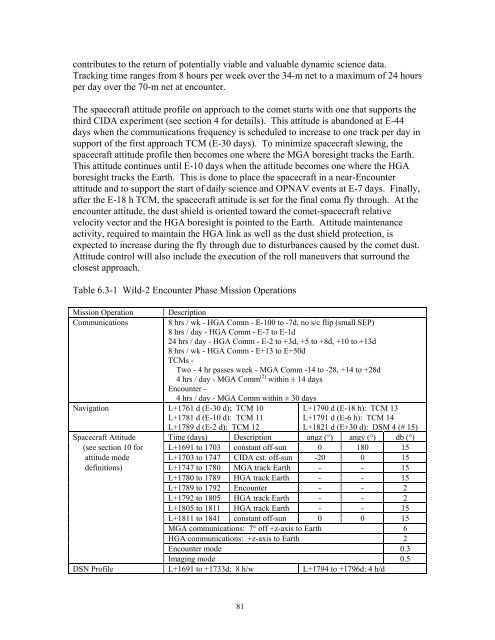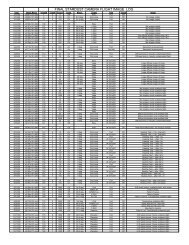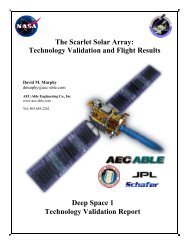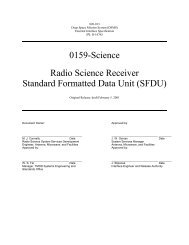MISSION PLAN - PDS Small Bodies Node
MISSION PLAN - PDS Small Bodies Node
MISSION PLAN - PDS Small Bodies Node
You also want an ePaper? Increase the reach of your titles
YUMPU automatically turns print PDFs into web optimized ePapers that Google loves.
contributes to the return of potentially viable and valuable dynamic science data.<br />
Tracking time ranges from 8 hours per week over the 34-m net to a maximum of 24 hours<br />
per day over the 70-m net at encounter.<br />
The spacecraft attitude profile on approach to the comet starts with one that supports the<br />
third CIDA experiment (see section 4 for details). This attitude is abandoned at E-44<br />
days when the communications frequency is scheduled to increase to one track per day in<br />
support of the first approach TCM (E-30 days). To minimize spacecraft slewing, the<br />
spacecraft attitude profile then becomes one where the MGA boresight tracks the Earth.<br />
This attitude continues until E-10 days when the attitude becomes one where the HGA<br />
boresight tracks the Earth. This is done to place the spacecraft in a near-Encounter<br />
attitude and to support the start of daily science and OPNAV events at E-7 days. Finally,<br />
after the E-18 h TCM, the spacecraft attitude is set for the final coma fly through. At the<br />
encounter attitude, the dust shield is oriented toward the comet-spacecraft relative<br />
velocity vector and the HGA boresight is pointed to the Earth. Attitude maintenance<br />
activity, required to maintain the HGA link as well as the dust shield protection, is<br />
expected to increase during the fly through due to disturbances caused by the comet dust.<br />
Attitude control will also include the execution of the roll maneuvers that surround the<br />
closest approach.<br />
Table 6.3-1 Wild-2 Encounter Phase Mission Operations<br />
Mission Operation<br />
Communications<br />
Description<br />
8 hrs / wk - HGA Comm - E-100 to -7d, no s/c flip (small SEP)<br />
8 hrs / day - HGA Comm - E-7 to E-1d<br />
24 hrs / day - HGA Comm - E-2 to +3d, +5 to +8d, +10 to +13d<br />
8 hrs / wk - HGA Comm - E+13 to E+50d<br />
TCMs -<br />
Two - 4 hr passes week - MGA Comm -14 to -28, +14 to +28d<br />
4 hrs / day - MGA Comm (2) within ± 14 days<br />
Encounter -<br />
4 hrs / day - MGA Comm within ± 30 days<br />
Navigation L+1761 d (E-30 d): TCM 10<br />
L+1781 d (E-10 d): TCM 11<br />
L+1789 d (E-2 d): TCM 12<br />
L+1790 d (E-18 h): TCM 13<br />
L+1791 d (E-6 h): TCM 14<br />
L+1821 d (E+30 d): DSM 4 (# 15)<br />
Spacecraft Attitude Time (days) Description angz (°) angy (°) db (°)<br />
(see section 10 for L+1691 to 1703 constant off-sun 0 180 15<br />
attitude mode L+1703 to 1747 CIDA cst. off-sun -20 0 15<br />
definitions) L+1747 to 1780 MGA track Earth - - 15<br />
L+1780 to 1789 HGA track Earth - - 15<br />
L+1789 to 1792 Encounter - - 2<br />
L+1792 to 1805 HGA track Earth - - 2<br />
L+1805 to 1811 HGA track Earth - - 15<br />
L+1811 to 1841 constant off-sun 0 0 15<br />
MGA communications: 7° off +z-axis to Earth 6<br />
HGA communications: +z-axis to Earth 2<br />
Encounter mode 0.3<br />
Imaging mode 0.5<br />
DSN Profile L+1691 to +1733d: 8 h/w L+1794 to +1796d: 4 h/d<br />
81






